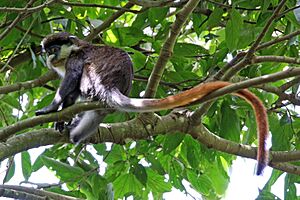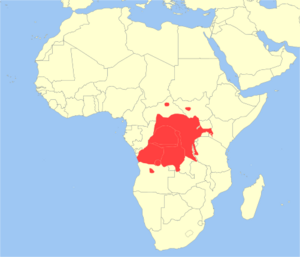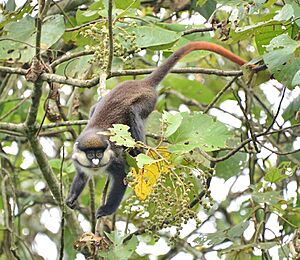Red-tailed monkey facts for kids
Quick facts for kids Red-tailed monkey |
|
|---|---|
 |
|
| Semliki Wildlife Reserve, Uganda | |
| Conservation status | |
| Scientific classification | |
| Genus: |
Cercopithecus
|
| Species: |
ascanius
|
 |
|
| Geographic range | |
The red-tailed monkey (Cercopithecus ascanius) is a cool type of primate (a group that includes monkeys, apes, and humans). People also call it the black-cheeked white-nosed monkey or red-tailed guenon. It gets its name from the reddish color on its tail!
You can find these monkeys in many countries in Africa. These include Angola, Cameroon, Central African Republic, Democratic Republic of the Congo, Kenya, Rwanda, South Sudan, Tanzania, Uganda, and Zambia. They can live in different places and conditions. This helps them spread out across the continent. Sadly, their homes are shrinking because of deforestation. Also, hunting can be a problem for them.
Contents
About the Red-Tailed Monkey
What They Look Like

The red-tailed monkey is easy to spot! It has a reddish tail, especially towards the tip. Its body fur is usually black or dark grey. But its nose and cheeks are white. This makes them stand out.
These monkeys also have big, stretchy cheeks. They use these like pouches to store food. This way, they can gather lots of food quickly. Then they can carry it to a safe spot to eat later.
Size and Weight
Red-tailed monkeys come in different sizes. Males are usually bigger than females. Their bodies are about 1 to 2 feet long. This measurement does not include their tail. Males are on the longer side, and females are a bit shorter.
Adult males weigh between 7 and 10 pounds. Females are a bit lighter, weighing 6 to 8 pounds. Their tails are super long! They can be up to 35 inches. That's twice as long as their body for some monkeys! The long tail helps them keep their balance when climbing.
How Red-Tailed Monkeys Behave
Talking and Signals
Red-tailed monkeys use many ways to talk to each other. They use sounds and body language. This helps them show who is in charge or to say hello.
When a younger monkey wants to show respect, it makes a soft, wobbly sound. They also greet each other by touching noses. This is a friendly sign. Sometimes, it leads to playful games.
They also use visual signals to warn others. If a monkey feels threatened, it might stare. It might also stare with its mouth open. They can lift their eyebrows to show the skin under their eyelids. This makes their eyes look bigger. On their dark fur, this is a clear sign to stay away! Another warning sign is head-bobbing. This is when they move their head up and down. These signals can be used alone or together. It depends on how much danger the monkey feels.
What They Eat
Red-tailed monkeys mostly eat fruit. But they are omnivores, meaning they eat both plants and animals. If fruit is hard to find, they will eat leaves, flowers, or insects.
When they look for food, they stuff it into their stretchy cheek pouches. This allows them to collect a lot of food quickly. Then they can move to a safer place to eat it. This way, other animals can't steal their meal.
Living in Groups
Red-tailed monkeys are social animals. They live in groups of 7 to 30 monkeys. Each group usually has one main male. The rest are females and their young.
These groups usually stay together all the time. The only ones who leave are young males when they grow up. These males might form groups with other males. Or they might live alone until they can take over a different social group.
The females in a group help each other raise their babies. This is called allomaternal care. They look after their own young and the young of other females. Sometimes, different groups of red-tailed monkeys will meet up. They do this when there's lots of food.
Red-tailed monkeys have even been seen hanging out with blue monkeys. They sometimes even groom each other!
Daily Life and Home
Red-tailed monkeys are most active in the early morning and evening. This is called being diurnal. They help spread seeds by eating fruit and then moving around. This helps new plants grow in the tropical forests of East and Central Africa.
They mostly live in trees. But they do come down to the ground. In the trees, they move very fast. On the ground, they walk on all four legs. Even though they prefer to be in trees, they spend a good amount of time on the forest floor looking for food.
Reproduction and Life Cycle
Like most mammals, red-tailed monkeys give birth to live young. They usually have one baby at a time. One male often mates with several females. This is common in many mammal groups.
The best time for them to have babies is from November to February. But they can have babies any time of the year. Sometimes, red-tailed monkeys even have babies with blue monkeys. These mixed-species babies have been seen in Gombe Stream National Park in Tanzania. This mixing might help both types of monkeys survive. It could even lead to a new species in the future!
How They Are Protected
The red-tailed monkey is listed as "least concern" by the IUCN Red List. This means they are not currently in danger of disappearing. They live in many different places in Africa. There are also many of them in these areas. They can live for about 28 years.
Some animals hunt red-tailed monkeys. These include crowned eagles, wild cats, and sometimes even humans and chimpanzees. Even with these threats, their population is generally stable. However, some areas where they live are losing trees due to deforestation. They also face hunting pressure in certain spots.



